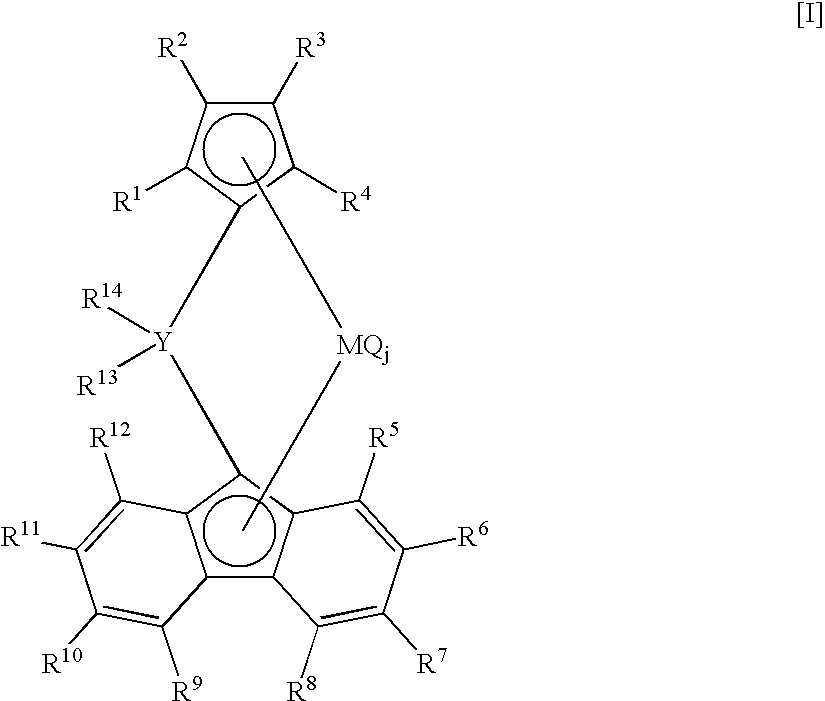Crosslinked metallocene compound for olefin polymerization and method of polymerizing olefin with the same
- Summary
- Abstract
- Description
- Claims
- Application Information
AI Technical Summary
Benefits of technology
Problems solved by technology
Method used
Image
Examples
example 1
Synthesis of dimethylmethylene(η5-cyclopentadienyl) (η5-octamethyloctahydrodibenzofluorenyl)zirconium dichloride
(i) Synthesis of octamethyloctahydrodibenzofluorene
[0172] Into a 500 ml three-necked flask thoroughly purged with nitrogen, equipped with a three-way cock, a dropping funnel and a magnetic stirrer, were introduced fluorene 9.72 g (58.6 mmol) and 2,5-dimethyl-2,5-hexanediol 19.61 g (134 mmol) at room temperature. Dehydrated dichloromethane 85 ml was further added, and the contents were stirred by the magnetic stirrer and cooled to −8° C. in an ice bath. Ground anhydrous aluminum chloride 38.9 g (292 mmol) was added to the mixture over a period of 70 minutes, and stirring was conducted for 2 hours at 0° C. and further for 19 hours at room temperature outside the ice bath. Thenthe resulting solutionwas quenched by being poured into ice water 150 ml. Soluble matters were extracted with diethyl ether 500 ml, and an organic phase was neutralized with a saturated aqueous solut...
example 2
Synthesis of diphenylmethylene (η5-cyclopentadienyl) (η5-octamethyloctahydrodibenzofluorenyl)zirconium dichloride
(i) Synthesis of diphenylmethylene(cyclopentadienyl) (octamethyloctahydrodibenzofluorenyl)
[0181] Into a 200 ml three-necked flask thoroughly purged with nitrogen, equipped with a three-way cock, a dropping funnel and a magnetic stirrer, were introduced octamethyloctahydrodibenzofluorene 2.64 g (6.8 mmol) and dehydrated tetrahydrofuran 40 ml. The contents were stirred by the magnetic stirrer and cooled to 2° C. in an ice bath. 1.63 mol / L n-hexane solution of n-butyllithium, 4.6 ml (7.5 mmol), was added to the mixture over a period of 10 minutes, and stirring was conducted for 23 hours at room temperature outside the ice bath. The slurry was cooled to 1° C. in an ice bath. Then a solution of 6,6-diphenyl fulvene 2.06 g (8.9 mmol) in 20 ml of dehydrated tetrahydrofuran was added to the slurry over a period of 20 minutes. The mixture was stirred for 65 hours at room temper...
example 3
Synthesis of cyclohexylidene(η5-cyclopentadienyl) (η5-octamethyloctahydrodibenzofluorenyl)zirconium dichloride
(i) Synthesis of cyclohexylidene(cyclopentadienyl) (octamethyloctahydrodibenzofluorenyl)
[0187] Into a 100 ml branched flask thoroughly purged with nitrogen, equipped with a dropping funnel and a magnetic stirrer, were introduced octamethyloctahydrodibenzofluorene 0.73 g (1.9 mmol) and dehydrated tetrahydrofuran 20 ml. The contents were stirred by the magnetic stirrer and cooled in an ice bath. 1.58 mol / L n-hexane solution of n-butyllithium, 1.3 ml (2.1 mmol), was dropwise added to the mixture, and stirring was conducted for 27 hours at room temperature outside the ice bath. The slurry was cooled in an ice bath. Then a solution of 6,6-cyclohexyl fulvene 0.31 g (2.1 mmol) in 10 ml of dehydrated tetrahydrofuran was dropwise added to the slurry. The mixture was stirred for 17 hours at room temperature outside the ice bath. The resulting solution was quenched by being poured i...
PUM
| Property | Measurement | Unit |
|---|---|---|
| temperature | aaaaa | aaaaa |
| reaction temperature | aaaaa | aaaaa |
| specific surface area | aaaaa | aaaaa |
Abstract
Description
Claims
Application Information
 Login to View More
Login to View More - R&D
- Intellectual Property
- Life Sciences
- Materials
- Tech Scout
- Unparalleled Data Quality
- Higher Quality Content
- 60% Fewer Hallucinations
Browse by: Latest US Patents, China's latest patents, Technical Efficacy Thesaurus, Application Domain, Technology Topic, Popular Technical Reports.
© 2025 PatSnap. All rights reserved.Legal|Privacy policy|Modern Slavery Act Transparency Statement|Sitemap|About US| Contact US: help@patsnap.com



